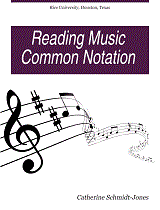
|
FreeComputerBooks.com
Links to Free Computer, Mathematics, Technical Books all over the World
|
|
- Title: Reading Music: Common Notation
- Author(s) Catherine Schmidt-Jones
- Publisher: Orange Grove Texts Plus (2009); eBook (Creative Commons Licensed)
- License(s): CC BY 3.0
- Paperback: 75 pages
- eBook: HTML and PDF (86 pages)
- Language: English
- ISBN-10: 1616100664
- ISBN-13: 978-1616100667
- Share This:

|
Reading music involves both skill and knowledge. In other words, you need to both understand how it works and also practice doing it. You won't improve without the practice, so learning how to read music will take some time and energy.
The understanding is also important, however; if you don't understand clearly how the symbols you see are related to the sounds you hear, you can end up practicing incorrectly, which wastes your time and may result in bad habits that are difficult to break.
If you have tried and failed to learn to read standard music notation for the mandolin or fiddle using traditional methods or you have never tried and want to, this book is for you. Learn to play from music in the mandolin- and fiddle-friendly major keys of C, G, D, A, F, and B-flat and their relative minor keys.
- Some basic definitions
- Practical suggestions for learning how to read music accurately and independently
- Practical suggestions for learning how to use sheet music as a guide and memory aid
- A discussion of alternative music notations
- A discussion of music reading vs. playing by ear
Generously illustrated and concise, this book is essential to any musician looking for a handy reference for the correct notation of music. A most welcome and beneficial source for every musician, whether using a pencil or a computer.
About the Authors- N/A
- Art, Music, and Related Books
- Computer, Digital, and Electronic Music
- Miscellaneous and Uncategorized Books

- Reading Music: Common Notation (Catherine Schmidt-Jones)
- Book Homepage
- Book Homepage (PDF, ePub, etc.)
-
 Understanding Basic Music Theory (Catherine Schmidt-Jones)
Understanding Basic Music Theory (Catherine Schmidt-Jones)
The main purpose of the book is to explore basic music theory so thoroughly that the interested student will then be able to easily pick up whatever further theory is wanted. Music history and the physics of sound are included.
-
 Understanding Music: Past and Present (N. Alan Clark, et al.)
Understanding Music: Past and Present (N. Alan Clark, et al.)
This book creates a roadmap from some of the earliest known origins of music to modern day. It covers the fundamentals of music and the physics of sound, an exploration of music from the Middle Ages to the present day.
-
 A Quick and Dirty Guide to Art, Music, and Culture (Clayton Funk)
A Quick and Dirty Guide to Art, Music, and Culture (Clayton Funk)
This is a guidebook to a web resource of Artist and Musician biographies. You will see relationships between art and music and what you are learning and the way you live, to connect them to your own experience.
-
 Understanding New Media Art (Elizabeth Bilyeu, et al)
Understanding New Media Art (Elizabeth Bilyeu, et al)
This is an introductory college art and art history courses that builds on scholarship in the field to propose a long historical context for the technologies and ideas related to New Media Art in the 21st century.
-
 Introduction to Art: Design, Context, and Meaning (P. J. Sachant)
Introduction to Art: Design, Context, and Meaning (P. J. Sachant)
This book offers a comprehensive introduction to the world of Art. It provides a new and free alternative to traditional textbooks, making it an invaluable resource in our modern age of technology and advancement.
-
 Music and Computers: A Theoretical and Historical Approach
Music and Computers: A Theoretical and Historical Approach
This book provides a resource and guide for those just beginning to look at the field of computer music, as well as for more advanced computer composers who might benefit from a fresh insight.
-
 Computer Music: Sound Science and Technology (Wikibooks)
Computer Music: Sound Science and Technology (Wikibooks)
This book is a comprehensive guide and reference that covers all aspects of computer music, including digital audio, synthesis techniques, signal processing, musical input devices, performance software, editing systems, algorithmic composition, MIDI, synthesizer architecture, system interconnection, and psychoacoustics.





